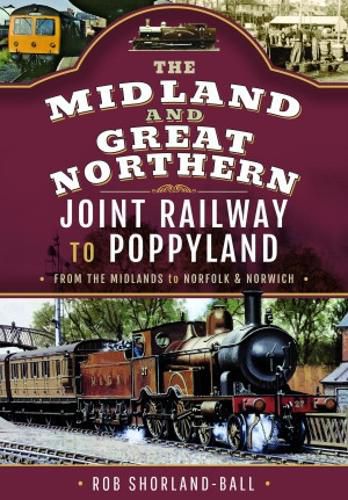Readings Newsletter
Become a Readings Member to make your shopping experience even easier.
Sign in or sign up for free!
You’re not far away from qualifying for FREE standard shipping within Australia
You’ve qualified for FREE standard shipping within Australia
The cart is loading…






M&GNJR was a Midlands to East Anglia railway linking towns and villages like a patchwork knitted together by clever business entrepreneurs. It started in the 1850s when there was intense rivalry between railway companies and two rich and powerful companies - MR and GNR - were behind the project. Joint,‘ added by a Special Act of Parliament in 1893, confirms this patchwork was the amalgamation of several small independent railway companies plus the MR and GNR. The company was especially interested in stealing a march on the Great Eastern Railway (GER) which believed it was the principal railway serving East Anglia. Poppyland was the nickname created for the Cromer area of the Norfolk coast by Clement Scott, an influential poet, author and drama critic of The Daily Telegraph who first visited in 1883. He claimed that … clean air laced with perfume of wild flowers was opiate to his tired mind.’ Scott publicised his delight and many rich families, and their servants, visited too; the railway business entrepreneurs saw a growing market for their patchwork. The M&GNJR grew eastwards to Norwich, Great Yarmouth, Lowestoft and attracted passengers from the Midlands and London. The M&GNJR grew - then withered as cars, buses, overseas travel offered new holiday options. Closure came on 28 February 1959 but North Norfolk Railway - the Poppy Line - has survived as a heritage line so the Joint is not forgotten!
$9.00 standard shipping within Australia
FREE standard shipping within Australia for orders over $100.00
Express & International shipping calculated at checkout
M&GNJR was a Midlands to East Anglia railway linking towns and villages like a patchwork knitted together by clever business entrepreneurs. It started in the 1850s when there was intense rivalry between railway companies and two rich and powerful companies - MR and GNR - were behind the project. Joint,‘ added by a Special Act of Parliament in 1893, confirms this patchwork was the amalgamation of several small independent railway companies plus the MR and GNR. The company was especially interested in stealing a march on the Great Eastern Railway (GER) which believed it was the principal railway serving East Anglia. Poppyland was the nickname created for the Cromer area of the Norfolk coast by Clement Scott, an influential poet, author and drama critic of The Daily Telegraph who first visited in 1883. He claimed that … clean air laced with perfume of wild flowers was opiate to his tired mind.’ Scott publicised his delight and many rich families, and their servants, visited too; the railway business entrepreneurs saw a growing market for their patchwork. The M&GNJR grew eastwards to Norwich, Great Yarmouth, Lowestoft and attracted passengers from the Midlands and London. The M&GNJR grew - then withered as cars, buses, overseas travel offered new holiday options. Closure came on 28 February 1959 but North Norfolk Railway - the Poppy Line - has survived as a heritage line so the Joint is not forgotten!